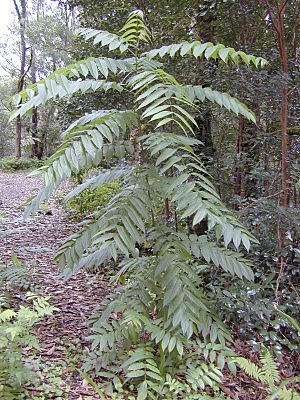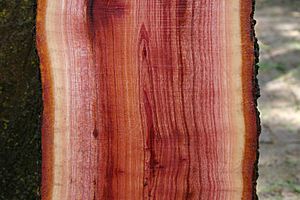Toona ciliata facts for kids
Quick facts for kids Toona ciliata |
|
|---|---|
 |
|
| Small specimen of Toona ciliata | |
| Conservation status | |
| Scientific classification | |
| Genus: |
Toona
|
| Species: |
ciliata
|
| Synonyms | |
|
|
The Toona ciliata is a tall forest tree. It belongs to the mahogany family. This tree grows in many parts of southern Asia, from Afghanistan all the way to Papua New Guinea and Australia.
Contents
What is Toona ciliata called?
This tree has many common names. It is often called the red cedar. Other names include toon or toona. In Australia, people sometimes call it the Australian red cedar or Queensland red cedar. It is also known as Indian cedar or Indian mahogany.
Some Indigenous Australians have their own names for it. These include Polai in the Illawarra region. On the Richmond River, it is called Woolia. Near Brisbane, it is known as Mamin and Mugurpul. At Wide Bay, it is called Woota. In Timor-Leste, it is known as Ai saria.
What does Toona ciliata look like?
This tree has long leaves that are made up of many smaller leaflets. These leaves can grow up to 90 cm (about 3 feet) long. Each leaf has 10 to 14 pairs of narrow leaflets. Each leaflet is between 4.5 and 16 cm long.
The Toona ciliata can grow very tall, up to 60 meters (about 200 feet) high. Its trunk can be as wide as 3 meters (about 10 feet) around. The tree has large branches that spread out, forming a wide top. It is one of the few native Australian trees that loses its leaves. Its leaves fall in autumn (around late March) and grow back in spring (early September). When new leaves appear, they are a pretty reddish-pink color.
The tree produces many tiny, white flowers. They are shaped like tubes. The fruits are green pods that turn brown when they are old. These pods open up into a star shape. Inside, they release small, winged seeds.
Where does Toona ciliata live?
In Australia, the Toona ciliata naturally grows in warm, wet forests. These are called subtropical and tropical forests. Most of these forests in New South Wales and Queensland have been cut down.
The southernmost place where this tree grows naturally is near Termeil, south of Ulladulla. It also grows on Norfolk Island. The biggest Toona ciliata tree ever recorded in Australia was cut down in 1883. It grew near Nulla Nulla Creek, west of Kempsey, New South Wales.
This tree grows best where there is a lot of sunlight. However, in the darker parts of the rainforest, it is less likely to be attacked by a bug called the cedar tip moth. This moth lays its eggs on the tree's main growing shoot. The baby moths then dig into the stem. This can damage the tree, making it grow many branches and become less valuable for wood. The tree gives off a smell that attracts the female cedar tip moth.
Interestingly, this moth does not attack Toona ciliata trees planted in South America. Because of this, Toona ciliata trees are now growing well in many parts of Brazil. People there are even working to grow stronger and better versions of the tree.
How is Toona ciliata used?
The wood from the Toona ciliata tree is red. It is easy to work with and is very valuable. Early settlers in Australia used it a lot for furniture, wall panels, and building things like ships. They even called it "red gold."
In the 1800s and early 1900s, too many of these trees were cut down. Almost all the large trees are gone now. This means the tree is no longer available for commercial logging in large amounts. Today, it is hard to find this wood. Some timber is still harvested in New Guinea. Even though it's not usually grown on big tree farms, some trees are harvested by the Forestry department in the Atherton area of Queensland.
Where else does Toona ciliata grow?
The red cedar is planted in many warm parts of the world. People plant it for shade and because it grows quickly. You can find it in the Hawaiian Islands in the United States, and in southern and eastern Africa. In some places like Zimbabwe and South Africa, it has started growing on its own. It grows to full size and spreads its seeds naturally there.
Toona ciliata reproduction
The Toona ciliata tree reproduces using its seeds. It produces a lot of seeds, and new trees grow easily from them.
Gallery
-
Toona ciliata - red leaves in September, Mount Keira, Illawarra, NSW
-
Toona ciliata bark, tree near Macksville, New South Wales, Australia
-
Stand of approximately 10 mature Toona ciliata, south of Drake, New South Wales, a rare sighting in this area
-
A stand of Toona ciliata near Kempsey, New South Wales
-
40-metre Toona ciliata, leafless in August, with epiphytic Dendrobium orchids at Barrington Tops, Australia
-
Eight-year-old seedling-planted Toona ciliata, Campo Belo, southeast Brazil
See also
 In Spanish: Toona ciliata para niños
In Spanish: Toona ciliata para niños

















